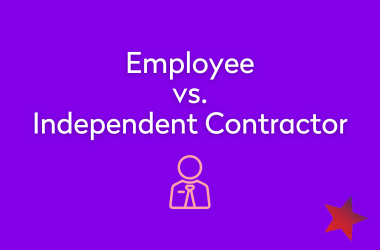Workers Classification in the Performing Arts: Why Does It Matter?
NEXTSTEPS GUEST WRITER: STEFI GEORGE
How You Classify Workers Can Make a Big Difference for Workers Compensation and Tax Considerations
Workers classification and taxes are two big considerations when hiring. For example, you hire an individual to perform services for your company. He asks to be treated as an independent contractor rather than an employee. Employees can be expensive – you have to pay social security and Medicare taxes, federal and state unemployment taxes, worker’s compensation premiums, and you may have to offer the employee health or other benefits. It all adds up. So, what should you do?
The answer is it depends. But before we get to the specifics of what facts are relevant to this determination, let’s discuss why it matters in the first place.
It is important to understand that no factor is determinative, and that, in some cases, certain factors will be more important than others.
Thus, before you respond to that request from the worker to be classified as an independent contractor, you need to evaluate all of the factors to determine whether such treatment is warranted under the circumstances. It is also critical to document your decision to the extent possible. Even if the IRS ultimately claims that you made the wrong choice, it is much easier to justify (and potentially avoid penalties) if the decision was well-reasoned at the time.
Exercise of Control Over Worker
To determine if a worker is an employee, the IRS considers the level of behavioral control, financial control and the nature of the relationship between the parties. Thus, the pivotal question is the level of control your company is exerting over that individual.
For instance, say you hire a dancer to perform at a single event, and she has discretion to wear whatever she wants and choreograph her own performance. That dancer is unlikely to be classified as an employee, since, although you may fix the time of the performance, your company is not controlling any of the other details of her performance. On the other hand, if you hire a dancer to go on tour as part of a company, schedule required rehearsals and performances at various venues of your selection, choreograph her performance and provide her with the costume she must wear, you are likely exercising sufficient control for her to be an employee.
Behavioral control exists when the company has the right to direct and control the work performed by the worker. Examples of behavioral control include:
- The company provides instruction to the employee as to when and where to work, what tools to use or where to purchase supplies
- The company provides detailed instructions as to how to perform the job
- The company evaluates how the worker performs his duties (as opposed to evaluating only the end result)
- The company provides training to the worker on how to do the job
Financial control exists when the company has the right to direct or control the financial aspects of the worker’s job. Examples of financial control are:
- The worker has no need to invest money in equipment or supplies because the worker does not perform services for others
- The worker does not incur unreimbursed expenses
- The worker does not offer services to the public
- The worker is guaranteed a regular wage amount
The nature of the relationship test looks at how the worker and the company perceive their relationship. Pertinent details supporting employee treatment include:
- The parties have a written contract specifying that the worker is an employee
- The company offers employee-type benefits to the worker
- The relationship is indefinite
- The services provided are integral to the company’s business
Conclusion
It is important to understand that no factor is determinative, and that, in some cases, certain factors will be more important than others.
Thus, before you respond to that request from the worker to be classified as an independent contractor, you need to evaluate all of the factors to determine whether such treatment is warranted under the circumstances. It is also critical to document your decision to the extent possible. Even if the IRS ultimately claims that you made the wrong choice, it is much easier to justify (and potentially avoid penalties) if the decision was well-reasoned at the time.
STEFI GEORGE IS A TAX PARTNER IN AKERMAN LLP’S NEW YORK OFFICE. SHE ADVISES ON ALL AREAS OF FEDERAL AND STATE TAX LAW, INCLUDING ISSUES FACING NONPROFIT ORGANIZATIONS. SHE IS PASSIONATE ABOUT ALL FORMS OF DANCE, WITH AN EMPHASIS ON BALLET.
Related Resources
Financial Audit Vs. Financial Review
Key Differences Between a Financial Audit & Financial ReviewA financial audit and review are two different types of financial assessments conducted by professionals to evaluate the accuracy and completeness of financial statements. The main difference between an...
Employee versus Independent Contractor
Employee vs. Independent ContractorWhat’s the difference between an employee and an independent contractor? The payment for an independent contractor is performance-based and is determined by the completion of the service they provide while an employee's payment is...
Checklist for Processing 1099’s and W2’s
Checklist for Processing 1099’s and W2’sEnd of Year Payroll Tax Forms: W2, 1099 Some of the most important payroll tax forms—W2 and 1099 forms—must be mailed out to your employees and contractors shortly after the calendar year ends. Any contractors who were paid more...



